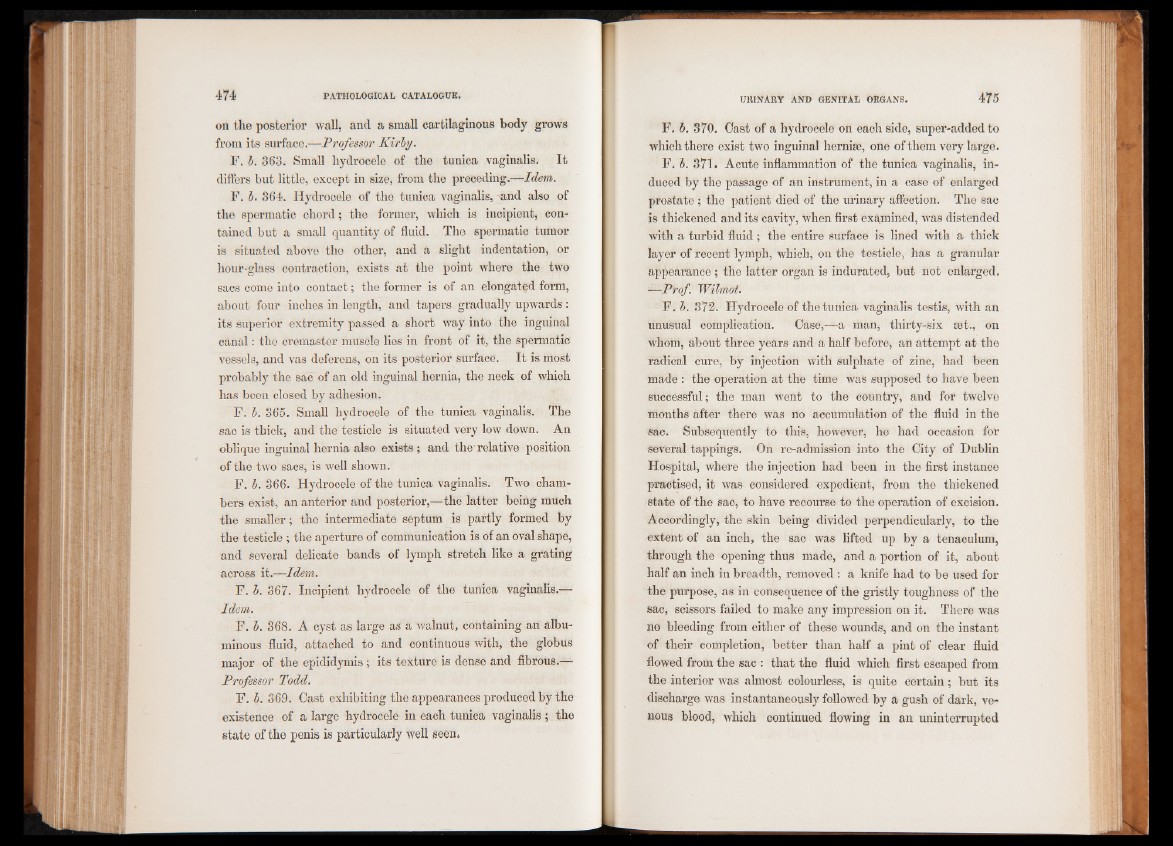
on the posterior wall, and a small cartilaginous body grows
from its surface.—Professor Kirby.
F. b. 363. Small hydrocele of the tunica vaginalis. It
differs but little, except in size, from the preceding.—Idem.
F. b. 364. Hydrocele of the tunica vaginalis, -and also of
the spermatic chord; the former, which is incipient, contained
but a small quantity of fluid. The spermatic tumor
is situated above the other, and a slight indentation, or
hour-glass contraction, exists at the point where the two
sacs come into contact; the former is of an elongated form,
about four inches in length, and tapers gradually upwards :
its superior extremity passed a short way into the inguinal
canal: the cremaster muscle lies in front of it, the spermatic
vessels, and vas deferens, on its posterior surface. It is most
probably the sac of an old inguinal hernia, the neck of which
has been closed by adhesion.
F. b. 365. Small hydrocele of the tunica vaginalis. The
sac is thick, and the testicle is situated very low down. An
oblique inguinal hernia also exists ; and the'relative position
of the two sacs, is well shown.
F. b. 366. Hydrocele of the tunica vaginalis. Two chambers
exist, an anterior and posterior,—the latter being much
the smaller; the intermediate septum is partly forined by
the testicle ; the aperture of communication is of an oval shape,
and several delicate bands of lymph stretch like a grating
across it.—Idem.
F. b. 367. Incipient hydrocele of the tunica vaginalis.—
Idem.
F. b. 368. A cyst as large as a walnut, containing an albuminous
fluid, attached to and continuous with, the globus
major of the epididymis; its texture is dense and fibrous.—
Professor Todd.
F. b. 369. Oast exhibiting the appearances produced by the
existence of a large hydrocele in each tunica vaginalis ; the
state of the penis is particularly well seen.
F. b. 370. Oast of a hydrocele on each side, super-added to
which there exist two inguinal hemise, one of them very large.
F. b. 371. Acute inflammation of the tunica vaginalis, induced
by the passage of an instrument, in a case of enlarged
prostate ; the patient died of the urinary affection. The sac
is thickened and its cavity, when first examined, was distended
with a turbid fluid; the entire surface is lined with a thick
layer of recent lymph, which, on the testicle, has a granular
appearance ; the latter organ is indurated, but not enlarged.
«—Prof. Wilmot.
F. b. 372. Hydrocele of the tunica vaginalis testis, with an
unusual complication. Case,—a man, thirty-six set., on
whom, about three years and a half before, an attempt at the
radical cure, by injection with sulphate of zinc, had been
made : the operation at the time was supposed to have been
successful; the man went to the country, and for twelve
months after there was no accumulation of the fluid in the
sac. Subsequently to this, however, he had occasion for
several tappings. On re-admission into the City of Dublin
Hospital, where the injection had been in the first instance
practised, it was considered expedient, from the thickened
state of the sac, to have recourse to the operation of excision.
Accordingly, the skin being divided perpendicularly, to the
extent of an inch, the sac was lifted up by a tenaculum,
through the opening thus made, and a portion of it, about
half an inch in breadth, removed : a knife had to be used for
the purpose, as in consequence of the gristly toughness of the
sac, scissors failed to make any impression on it. There was
no bleeding from either of these wounds, and on the instant
of their completion, better than half a pint of clear fluid
flowed from the sac : that the fluid which first escaped from
the interior was almost colourless, is quite certain; but its
discharge was instantaneously followed by a gush of dark, venous
blood, which continued flowing in an uninterrupted